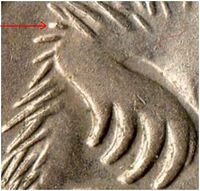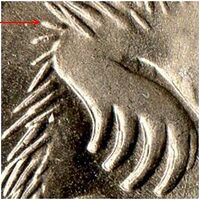Australian ten-cent coin
Production:
The ten-cent coin was first introduced as part of Australia's transition to decimal currency on February 14, 1966. This transition marked a significant change in the nation's monetary system, moving away from the pounds, shillings, and pence system to a more straightforward decimal system.
The original reverse design of the ten-cent coin features a lyrebird, an iconic Australian bird known for its extraordinary ability to mimic natural and artificial sounds. Remarkably, this design has remained unchanged since its introduction, making it a consistent and recognizable symbol on the coin.
While the reverse design has stayed the same, the obverse design underwent a notable alteration in 2016. This change was made to commemorate the 50th anniversary of the introduction of decimal currency in Australia. However, the steadfast lyrebird on the reverse side continues to grace the ten-cent coin, preserving a piece of the original design for collectors and the general public alike.
The production of the ten-cent coin began with the first issues in 1966, all of which were minted at the Royal Mint in London. Following this initial production run, the responsibility for minting ten-cent coins shifted to the Royal Australian Mint in Canberra and the Royal Mint in Llantrisant, Wales. This transition reflects the evolving nature of coin production and the collaborative efforts between different mints to ensure the availability of ten-cent coins for circulation in Australia.
| Value | Mass | Diameter | Edge | Composition |
|---|---|---|---|---|
| $0.10 AUD | 5.65 g | 23.60 mm | Milled | 75% copper 25% nickel |
| Obverse | Design | Designer | Design date | |
| Elizabeth II | Arnold Machin | 1966-1984 | ||
| Elizabeth II | Raphael Maklouf | 1985-1998 | ||
| Elizabeth II | Ian Rank-Broadley | 1999-2015
2017-2019 | ||
| Elizabeth II and Reproduction of 1953-1964 One Penny | Ian Rank-Broadley | 2016 | ||
| Elizabeth II | Jody Clark | 2019-2023 | ||
| Elizabeth II
Special Memorial |
Jody Clark | 2023 | ||
| Charles III | Dan Thorne | 2024-Present | ||
| Reverse | Design | Designer | Design date | |
| lyrebird | Stuart Devlin | 1966-Present | ||
| Mintage year | 1966 | 1966 | 1967 | 1968 | 1969 | 1970 | 1971 | 1972 | 1973 | 1974 | 1975 | 1976 | 1977 | 1978 |
|---|---|---|---|---|---|---|---|---|---|---|---|---|---|---|
| Mintage (Mil) | 30.0 | 11.0 | 51.0 | 57.2 | 22.1 | 22.3 | 20.7 | 12.5 | 27.3 | 46.6 | 50.9 | 57.1 | 10.9 | 48.4 |
| Mint | RML | RAM | RAM | RAM | RAM | RAM | RAM | RAM | RAM | RAM | RAM | RAM | RAM | RAM |
| Mintage year | 1979 | 1980 | 1981 | 1981 | 1982 | 1983 | 1984 | 1985 | 1988 | 1989 | 1990 | 1991 | 1992 |
|---|---|---|---|---|---|---|---|---|---|---|---|---|---|
| Mintage (Mil) | 37.0 | 55.6 | 76.1 | 40.0 | 61.5 | 82.3 | 25.7 | 2.0 | 48.1 | 43.5 | 25.0 | 4.8 | 46.7 |
| Mint | RAM | RAM | RAM | RML | RAM | RAM | RAM | RAM | RAM | RAM | RAM | RAM | RAM |
| Mintage year | 1993 | 1994 | 1997 | 1998 | 1999 | 2000 | 2001 | 2002 | 2003 | 2004 | 2005 | 2006 |
|---|---|---|---|---|---|---|---|---|---|---|---|---|
| Mintage (Mil) | 23.1 | 43.7 | 5.7 | 48.0 | 97.1 | 51.1 | 109.4 | 70.3 | 53.6 | 89.1 | 116.7 | 157.1 |
| Mint | RAM | RAM | RAM | RAM | RAM | RAM | RAM | RAM | RAM | RAM | RAM | RAM |
| Mintage year | 2007 | 2008 | 2009 | 2010 | 2011 | 2012 | 2013 | 2014 | 2015 | 2016 | 2016 | 2017 | 2018 | 2019 |
|---|---|---|---|---|---|---|---|---|---|---|---|---|---|---|
| Mintage (Mil) | 61.1 | 136.0 | 25.3 | 84.9 | 1.7 | 54.0 | 49.2 | 66.44 | 14.3 | 42.0 | 6.21 | 21.6 | 3.3 | 17.02 |
| Mint | RAM | RAM | RAM | RAM | RAM | RAM | RAM | RAM | RAM | RAM | RAM | RAM | RAM | RAM |
| Mintage year | 2019 | 2020 | 2021 | 2022 | 2023 | 2024 |
|---|---|---|---|---|---|---|
| Mintage (Mil) | 2.03 | 23.2 | 22.8 | 9.14 | ||
| Mint | RAM | RAM | RAM | RAM |
| RAM = Royal Australian Mint; RCM = Royal Canadian Mint; RML = Royal Mint, London; RMLL=Royal Mint, Llantrisant |
| 1 = 50th Anniversary, 2= IRB, 3 = JC |
Mint Marks:
The two different variants of the 1966 Australian five-cent coin minted in London and Canberra can be readily distinguished by a key visual difference in their reverse designs. Specifically, the length of the spine on the echidna's front right shoulder is notably longer on the coins produced at the Royal Mint in London compared to the shorter spine on the Canberra-minted coins from the Royal Australian Mint.
This subtle but distinct design variation provides a helpful diagnostic feature for collectors and enthusiasts seeking to differentiate between the two 1966 five-cent coin varieties. The longer spine on the London-minted coins creates a more pronounced and pronounced quill-like appearance, whereas the Canberra coins have a shorter, less emphasized spine on the same part of the echidna's body.
In terms of production numbers, the Royal Mint in London struck 30 million of the 1966 five-cent coins. Meanwhile, the Canberra facility of the Royal Australian Mint produced over 45 million examples of the 1966 five-cent piece. As a result, the Canberra-minted coins are the more prevalent and commonly encountered of the two 1966 five-cent varieties among collectors and in circulation.
This clear visual distinction and difference in mintage figures makes the longer vs. shorter spine on the echidna's front right shoulder an essential diagnostic tool for identifying the origin mint of individual 1966 Australian five-cent coins. It's a key detail that numismatists and coin enthusiasts can use to accurately attribute and catalogue examples of this important decimal currency issue.
| RAM (Canberra) | RML (London) |
|---|---|

|

|
| Canberra Mint: Short spine. | London Mint: Longer spine. |